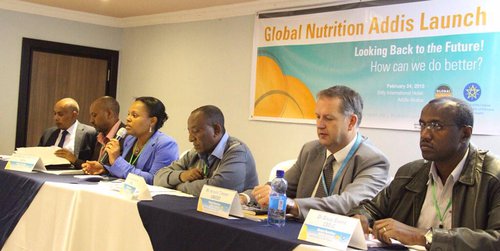Ambition and Analysis: The Addis Ababa GNR Roundtable
The Global Nutrition Report Roundtable event in Addis Ababa was hosted by the Government of Ethiopia’s Ministry of Health and attended by over 100 people. Ferew Lemma and Augustin Flory are the new co-chairs of the Report’s Stakeholder Group (taking over from Edith Mkawa and Jane Edmonson who did a great job for 2014) and it was fitting that Ferew was the key shaper of the event.
The Roundtable celebrated Ethiopia’s successes in driving down stunting rates. We noted the commitment of the Government to nutrition as evidenced by its membership of SUN, its commitments at the Nutrition for Growth summit in 2013 and its support for the Global Nutrition Report process.
In prepping for the Roundtable, I used the Ethiopia Nutrition Country Profile which notes that:
- Only 10% of births have skilled attendants while antenatal care rates are low at 19%. Exclusive breastfeeding is just above the WHA 2025 target of 50%. But more is better, and the rate of exclusive breastfeeding has not increased for the past 11 years. But the real vulnerability is the state of infant and young child feeding, with both indicators at 5% or less suggesting that 95% of children 6-23 months of age do not eat enough food of the right quantity or quality.
- At the underlying level—i.e. drivers that are not interventions or practices per se, but are known to be strongly linked to nutrition status—estimates of hunger have declined significantly in the past 14 years (from 56% to 35%). But female secondary enrollment rates for the most recent year are only at 11% in 2000 (compared to over 30% for Africa) and Ethiopia ranks 121 (out of 151) in the UNDP Gender Inequality Index. On access to improved water and sanitation, progress is rapid but the levels of improved sanitation (37%) and improved water (52%) remain low. Strong and positive trends in government spending on social protection and education suggest the improvements in underlying determinants will improve.
- The opportunities for action seem clear: improve infant and young child feeding through complementary feeding programmes, dramatically improve secondary enrollment rates of girls and try to make social protection and education investments more nutrition sensitive. Other opportunities for action relate to policy and legislation: few provisions of the international code of marketing of breast milk substitutes are enshrined in law; nutrition does not feature as much in national development plans and economic policies as it does in many other countries (68th out of 83), wheat fortification legislation is rated as in the planning phase, and maternity protection, so crucial for child feeding of working mothers is still “partial”.

The Roundtable touched on several of these issues. What struck me from the presentations on the day was the ambition of the Ethiopian Government on nutrition targets and its use of analysis. On ambition, Ferew Lemma a senior official in the Ministry of Health and the SUN focal point, outlined the target for 2020 on stunting: 26%. Remember, the latest mini DHS suggests a stunting rate of 40% in 2014. That is a decline of 14 percentage points in 5 years. This is about what Maharashtra achieved. The targets are tied to the projections of Ethiopia becoming a middle income country by 2020 (based on GNP per capita).
On analysis, we were told of the remarkable story of the Productive Safety Net Programme (PSNP) which has been going for about 10 years now. The new PSNP4 will be more nutrition sensitive than the current PSNP3. Noting that it is not easy to design or deliver nutrition sensitive programmes at scale (PSNP reaches 10 million people) I asked about the process of change. How was the Minister of Agriculture persuaded to adopt nutrition sensitivity? I was told it was analysis, persistence over 3 years, and an influencing strategy that embraced pressure from within the Ministry of Agriculture and from elsewhere in the government, as well as persuasion from outside (UN agencies and noting that all the donors who fund PSNP also fund nutrition).
The embrace of analysis was interesting: an evaluation (by John Hoddinott at IFPRI) from 2013 showed that while PSNP3 was improving diet diversity and food security at the household level it was not having any impact at the under 2 level. This helped support the drive for the nutrition-sensitive changes. The ambition of PSNP4 is so striking that Tom Arnold said (and I agree with him) that global leadership on innovation for safety nets and nutrition may well be shifting to Ethiopia away from places like Mexico and Brazil.
Clearly the commitment to improving nutrition is high from all Ethiopian stakeholders. While the iron is hot, there are 2 things I would like the government to consider. First, consult more about how to tackle wasting rates (perhaps linked to relatively low coverage of improved sanitation and water?). Wasting rates are still high at 9-10% and they are stuck. Second, pay as much attention to child growth as it does to economic growth. The new 5 year Growth and Transformation Plan (current one here) will come into effect later in 2015. In the Plan, the Government of Ethiopia should give nutrition the same prominence as it will give to things such as hard infrastructure and macroeconomic policy stability. Human infrastructure is vital too.
Middle income status is a hollow victory if low income malnutrition rates persist. For that to be avoided, Ethiopia needs to have a middle income nutrition plan for development and a middle income development plan for nutrition.
---
Press coverage:
- Ethiopia performing well in reducing stunting
- Ethiopia makes progress in reducing stunting among under- 5 children – official
- Global report praises Ethiopia for minimizing child stunting
- Ethiopia reduces stunting, wasting rates still high - nutrition report
- Nutrition: An incredible opportunity for Ethiopia's present and future